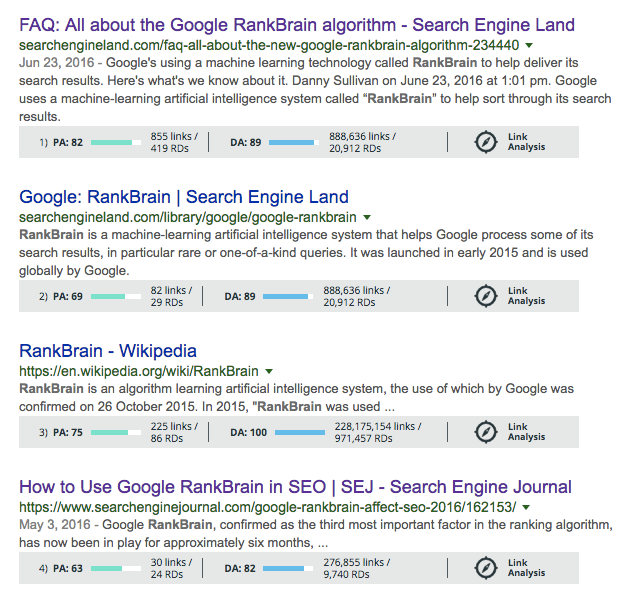Top Search Ranking Factors for 2017: How to Make Your Own RankBrain List [Free Worksheet]
There is no one-size-fits-all list of SEO ranking factors.
At one time, SEOs—regardless of industry—could refer to a single list of Google’s 200 ranking factors to optimize their sites and content. And while that list is still a good starting point, Google’s latest machine learning program now changes the priority of those factors based on a variety of considerations, including industry, topic, and user intent. Ranking factors are reprioritized for each query.
RankBrain learns what types of information searchers are looking for when using specific keywords by collecting engagement data from how users interact with search results. It then uses that information to refine future results and prioritize relevant ranking factors. As a result, search ranking factors in 2017 and beyond are no longer universal.
To succeed with SEO in the age of RankBrain, you have to create your own ranking factors list—one that’s catered to your industry’s and audience’s specific needs and preferences.
Sound daunting? Scroll to the bottom of this post to download our free, RankBrain-inspired Ranking Factors Worksheet. This spreadsheet provides the structure you need to interpret ranking factors for your core keywords.
How to Develop a List of Relevant Search Ranking Factors for Your Content
RankBrain establishes the relevance and importance of Google’s 200+ ranking factors using a variety of inputs. High-level inputs like industry and location are considered, as well as individualized inputs like a user’s historical search behavior and preferred content medium.
For example, keywords and links used to be the backbones of SEO, but—on average—only 53% of top 20 results have keywords in their titles, and inbound links are less important than they were in the past.
Developing a list of relevant search ranking factors requires identifying patterns in existing, top organic search results for queries that are related to your industry. By taking the time to research what RankBrain is currently prioritizing for relevant queries, you can establish a To-Do list for your content to help it perform well in organic search.
Start by conducting a depersonalized search for a relevant keyword, and look for illustrative consistencies:
- Depth of Coverage – Are the top results short landing pages, or are they long and comprehensive resources? This highlights the amount of information that users are looking for. If top results are detailed guides, it signals that in-depth coverage is likely a positive ranking factor for the query you searched. If top results are landing pages, users are likely more interested in feature lists and product highlights.
- Related Topics – Obviously, top results will cover topics pertaining to the keyword you searched, but do they cover related topics as well? For example, top results for the keyword “content marketing” may also include information on SEO, social media marketing, content strategy, and display advertising. If so, inclusion of related topics may be a positive ranking factor.
- Content Medium – Look at how information is presented in the top results. Do top results have consistencies in the format—text, videos, infographics, interactive tables, ebooks, PDFs, checklists? If most of the top results contain videos, it’s probably because users prefer videos. That said, the absence of a type of content does not necessarily mean it won’t work—it might mean no one has tried yet. Start by echoing the type of content that is ranking well, but evaluate opportunities to be the first to try something new.
- Freshness – When were the top results published? If they have varying publication dates that span multiple years, content freshness is likely not a factor. However, if they were all published within the last few weeks, content freshness may be important. For some queries, users are looking for the most up-to-date information.
- Inbound Links – In some cases, number and quality of inbound links may be a ranking factor. Use a tool like MozBar to quickly identify number of inbound links for top results and the authority of the overall domains.

Top organic results for [rankbrain] all have a lot of backlinks, which indicates it is probably a strong ranking factor.
When this exercise is completed, you’ll have a list of relevant ranking factors for the content you’re preparing to create. If the top three results are all presented as lists (“X Ways,” “Y Steps,” etc.), you might use that format for your title. If the top results all have dozens of inbound links, you’ll likely need to engage in content promotion activities after publishing to earn inbound links.
By conducting this research before writing new content, you can determine which ranking factors RankBrain is prioritizing. This information can be used to guide content creation and optimization.
There are some additional factors to consider, but they come into play after content is published.
Evaluating Engagement Ranking Factors
Instead of relying on inbound backlinks to determine content quality, RankBrain utilizes engagement signals. Factors like click-through rates, time-on-page, and pages per session can present strong signals to Google about a piece of content’s quality and relevance to queries:
- If a piece of content is in position one in Google results, but users are clicking more often on the content in position two, it’s likely that the content in position one isn’t satisfying the query and will probably lose its top spot soon.
- Likewise, if users click the content but return to search results without spending much time on the page, it could signal low content quality or content that doesn’t meet searcher intent. Expect rankings to start dropping.
- If user clicks on a result and goes on to view multiple pages on the site, it could be a signal of site credibility and authority, and Google might start preferring it more.
Once content is published, it’s time to determine whether or not searcher engagement is impacting rankings. To do this, pull click-through rate (CTR), time on page, and pages-per-session metrics from Google Search Console and Google Analytics.
- Click-through rates can be found in Google Search Console by expanding “Search Traffic” and clicking on “Search Analytics.” Then, make sure “CTR” and “Position” are checked, and select the “Pages” radio button. This will show the average position of pages in search results and how often results are clicked. Pages with decent SERP positions but low CTRs may need to be updated with more enticing search snippets.

- Time on page can be found in Google Analytics by expanding the “Behavior” tab, expanding “Site Content,” and clicking “All Pages.” Low average time-on-page values signify low engagement. Take time to review your content and compare it to other top search results to determine why users aren’t engaging. You can also use a tool like Read-o-Meter to determine how long it should take users to read your content.

- Pages-per-session can be used by RankBrain to evaluate your site’s overall credibility and usefulness. Find pages-per-session metrics in Google Analytics by expanding the “Audience” tab and clicking “Overview.” Higher pages-per-session values signals effective funneling and engaged visitors. Low pages-per-session may signify low engagement, ineffective funneling, or confusing site navigation.
By taking steps to improve user engagement with your site and content, users will send signals to RankBrain that the content you’re producing is relevant, useful, and credible. These signals should help you climb results in the SERPs and overtake your competition.
Creating a Personalized List of Search Ranking Factors
RankBrain has made universal ranking factors obsolete. The sites that excel in the SERPs today cater specifically to audience needs and preferences. And the only way to do this is to determine exactly what users are looking for when entering the keywords and search queries you’re targeting.
To get started on the task of creating your personalized list of search ranking factors, download our RankBrain-inspired Ranking Factors Worksheet template. Determine what factors RankBrain is prioritizing for targeted queries, and use those factors to create content that overtakes competitors in search results.
Download the Worksheet:
What's Next?
Profound Strategy is on a mission to help growth-minded marketers turn SEO back into a source of predictable, reliable, scalable business results.
Start winning in organic search and turn SEO into your most efficient marketing channel. Subscribe to updates and join the 6,000+ marketing executives and founders that are changing the way they do SEO:
And dig deeper with some of our best content, such as The CMO’s Guide to Modern SEO, Technical SEO: A Decision Maker’s Guide, and A Modern Framework for SEO Work that Matters.





